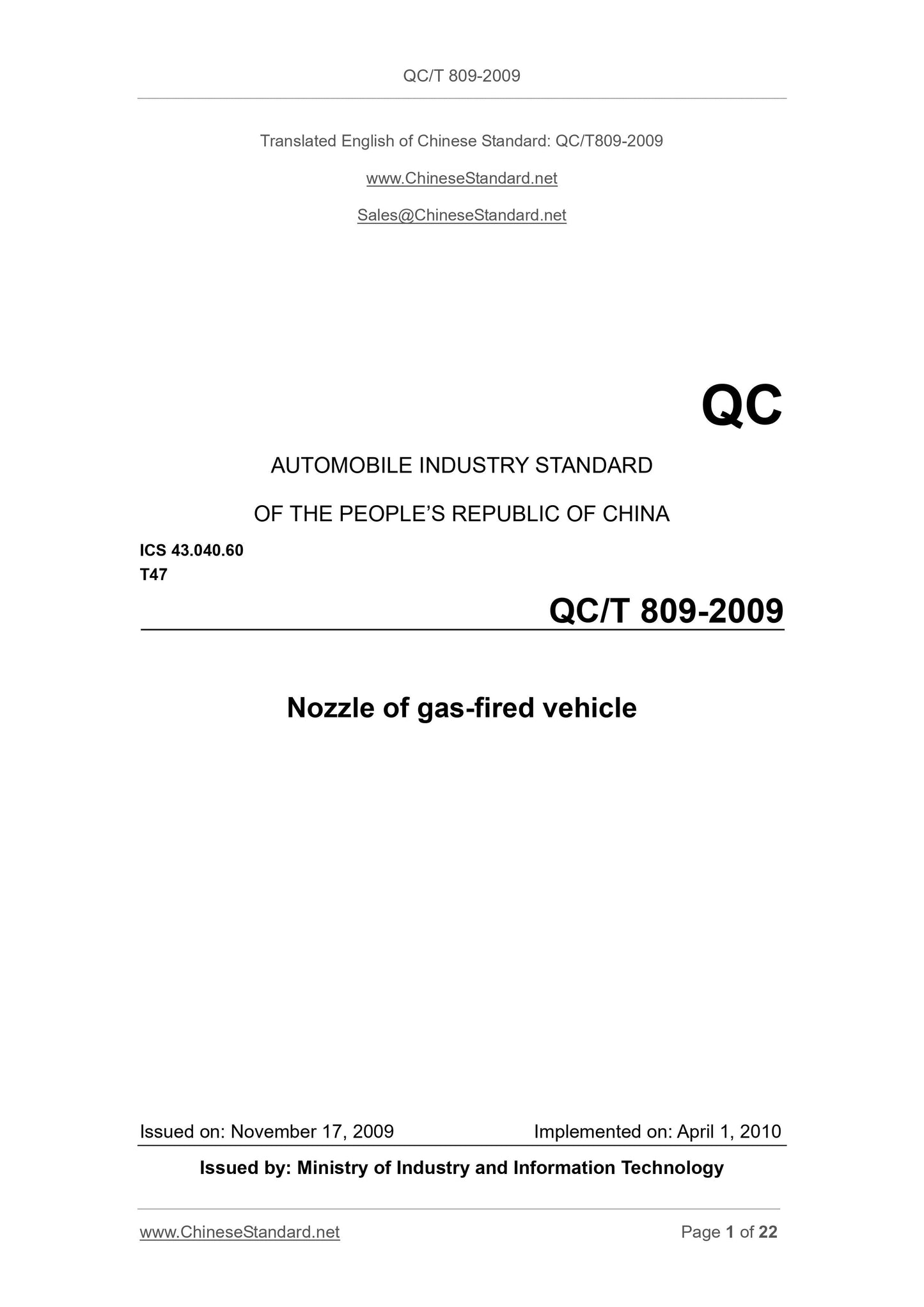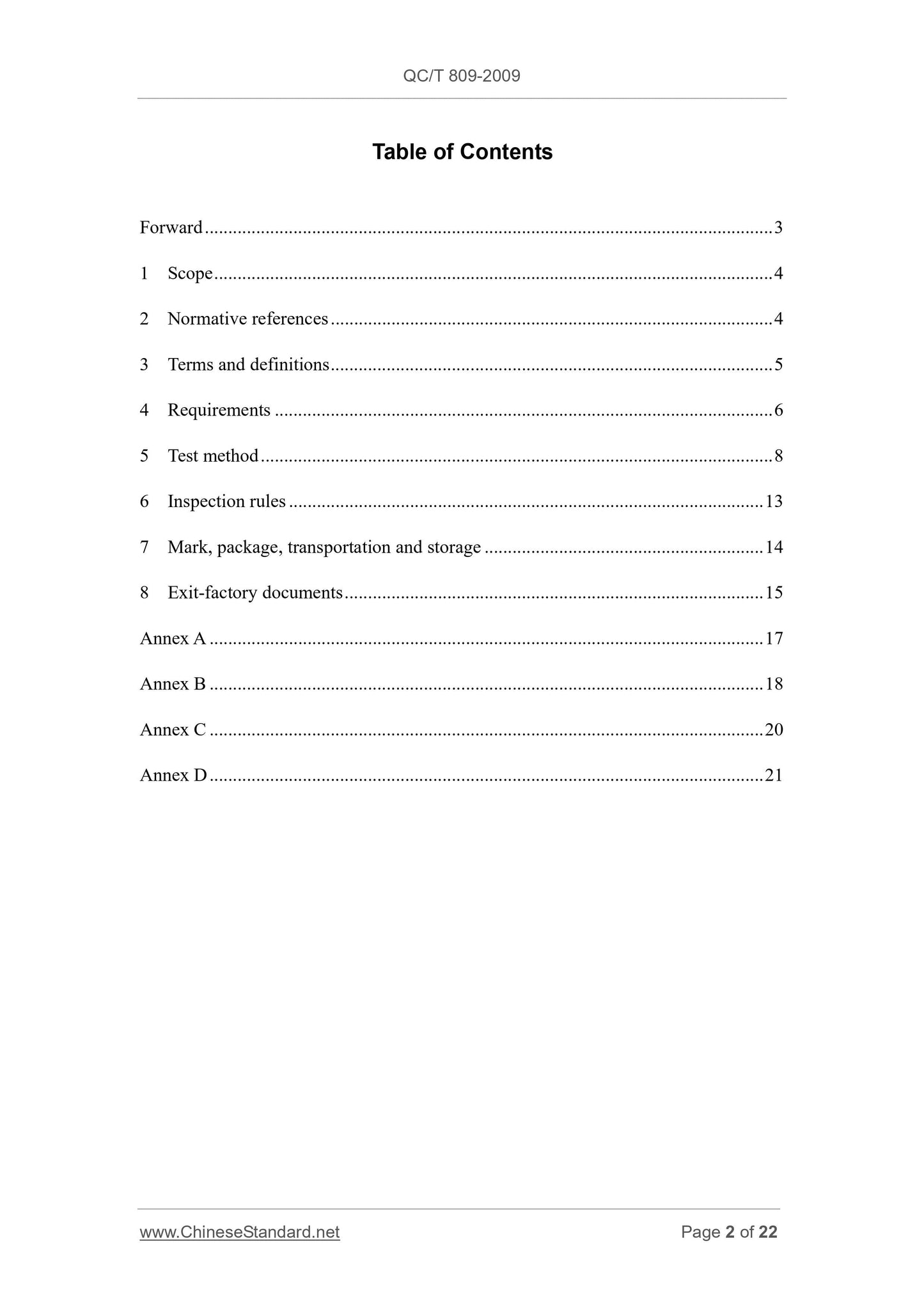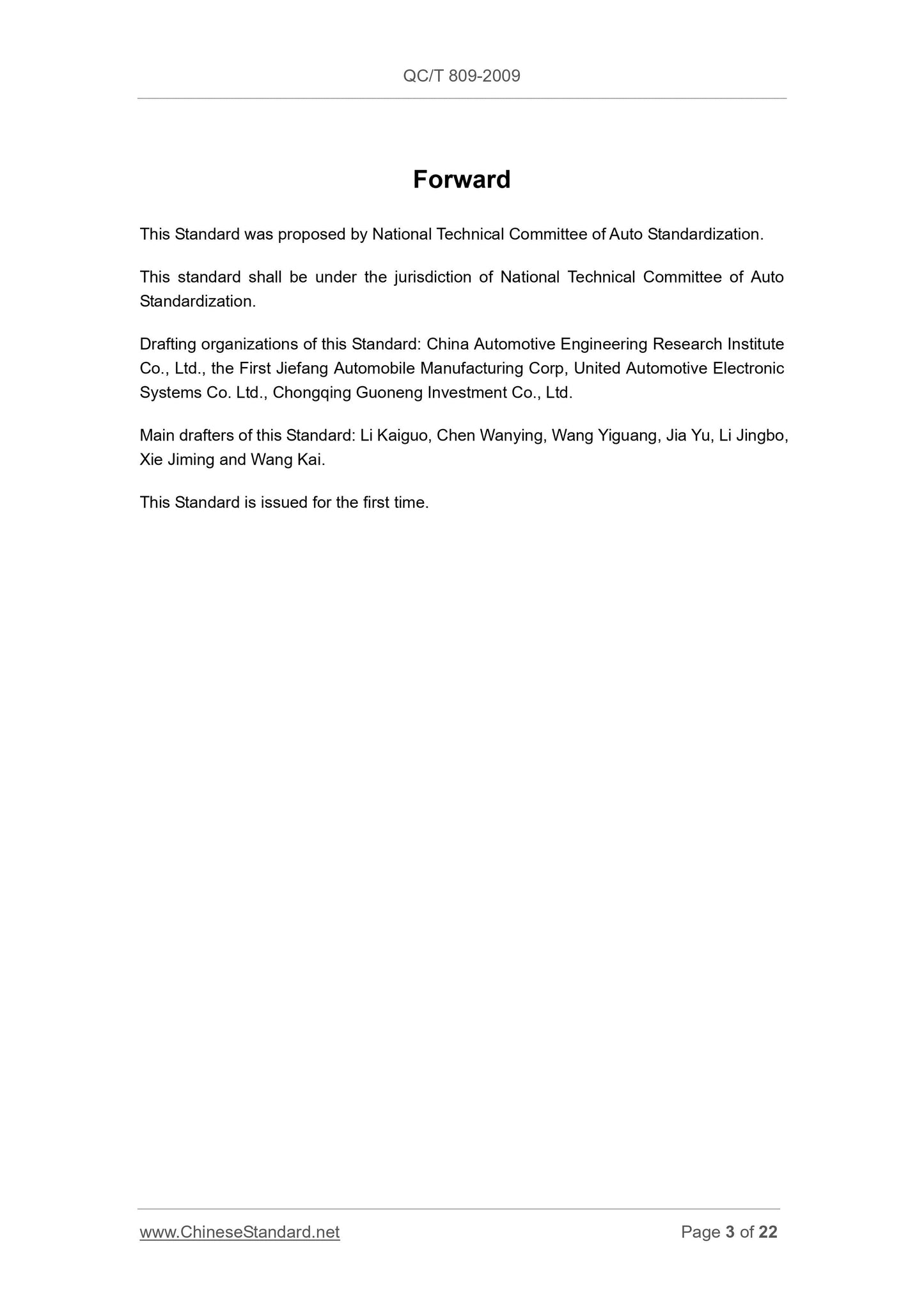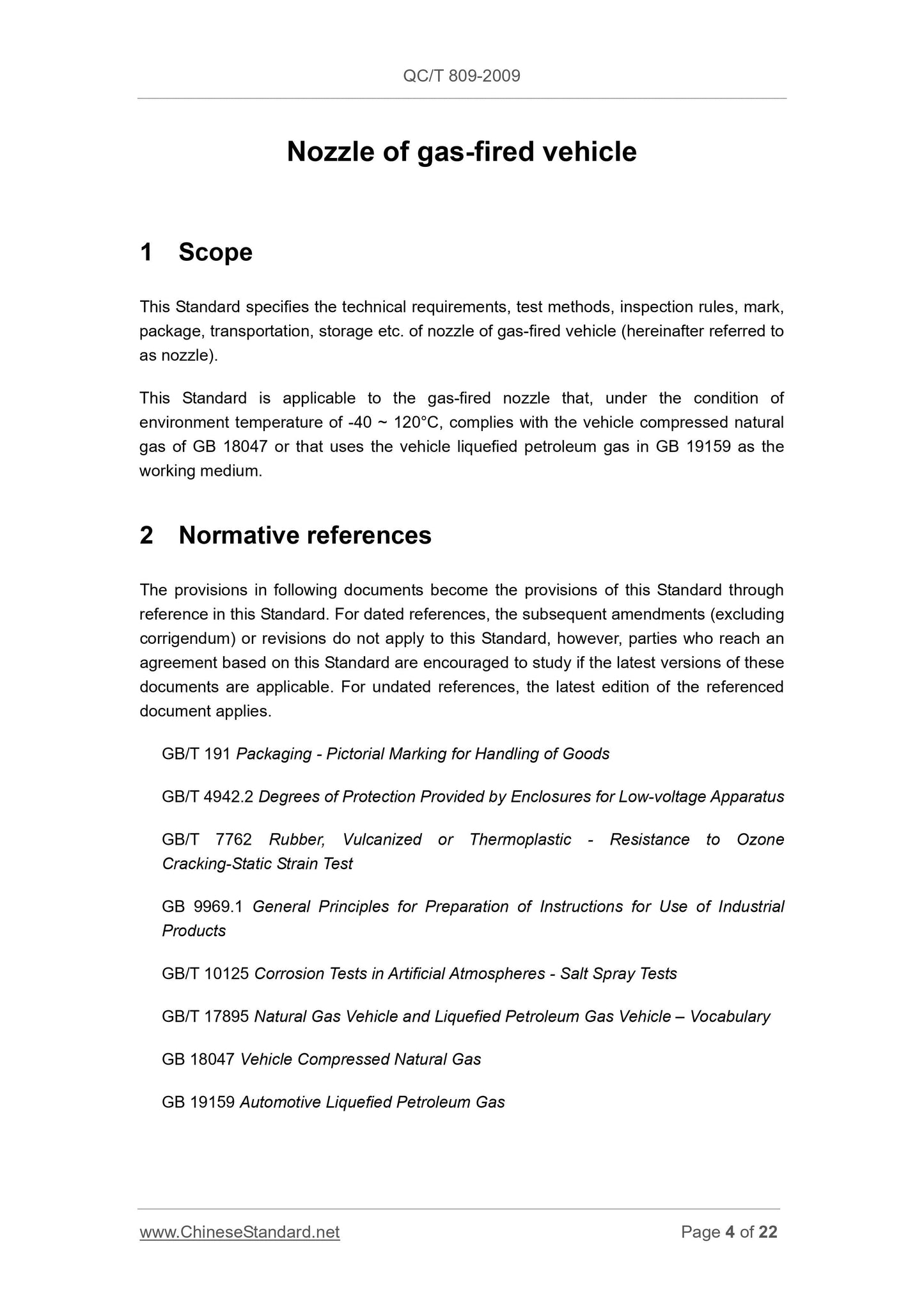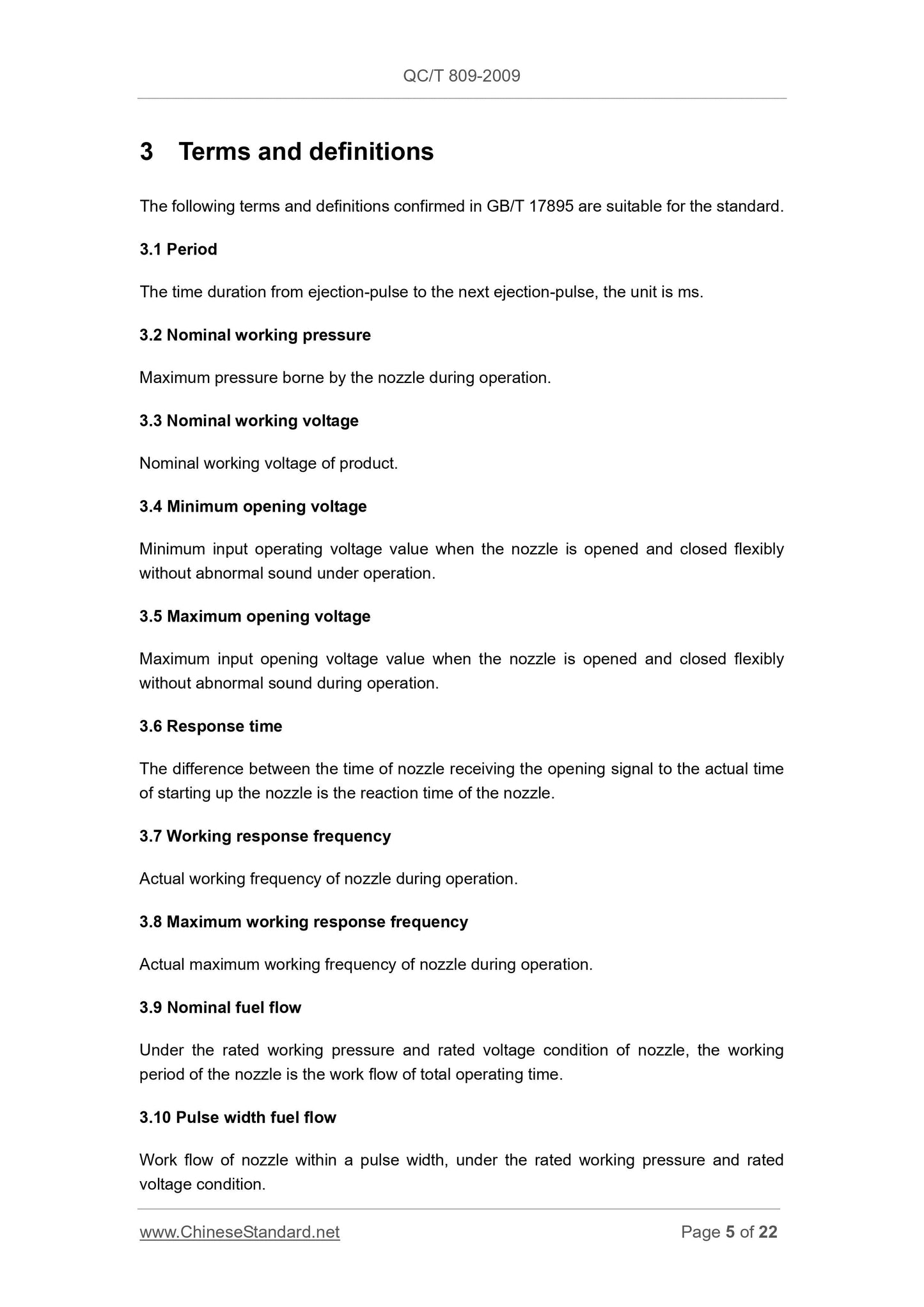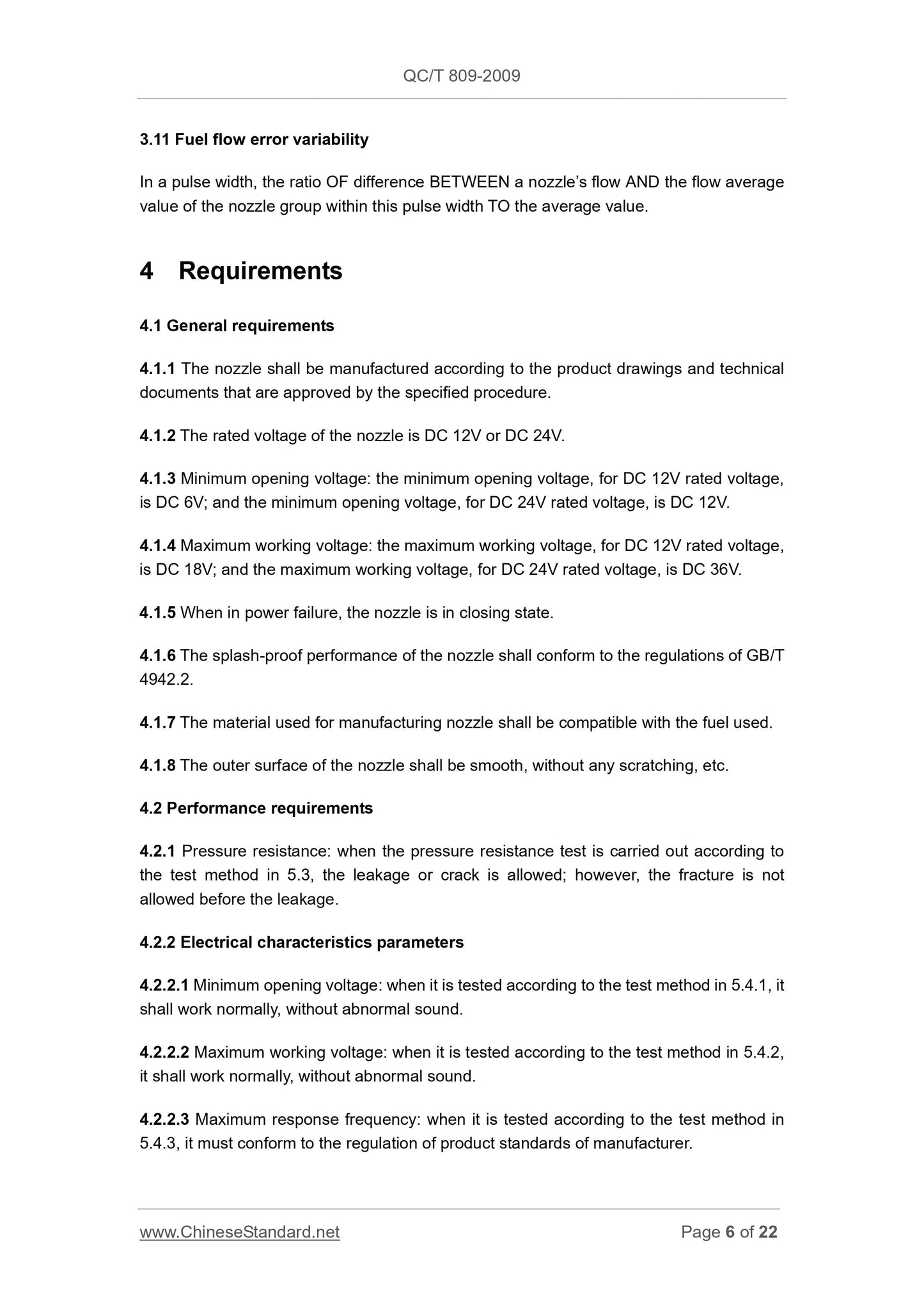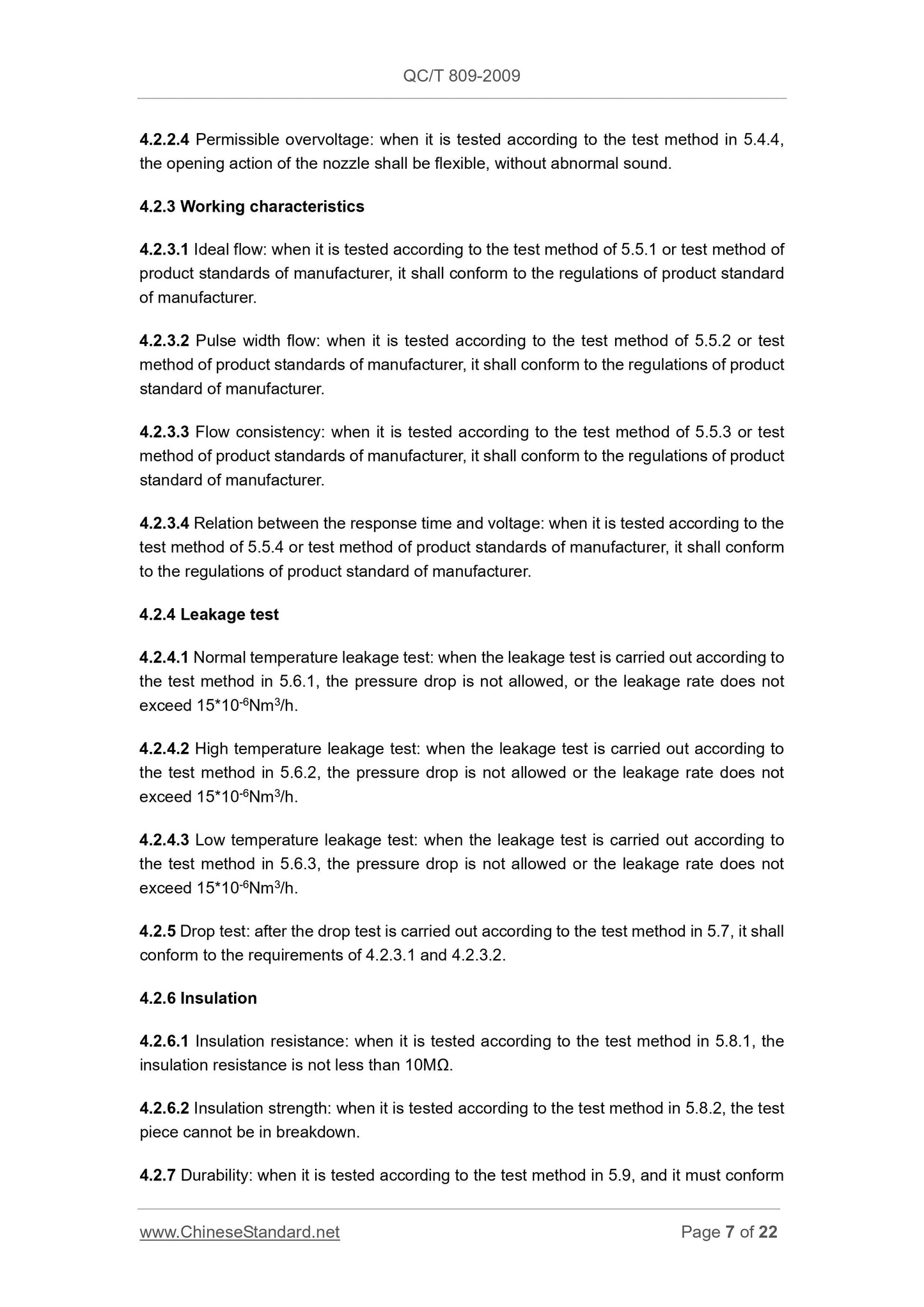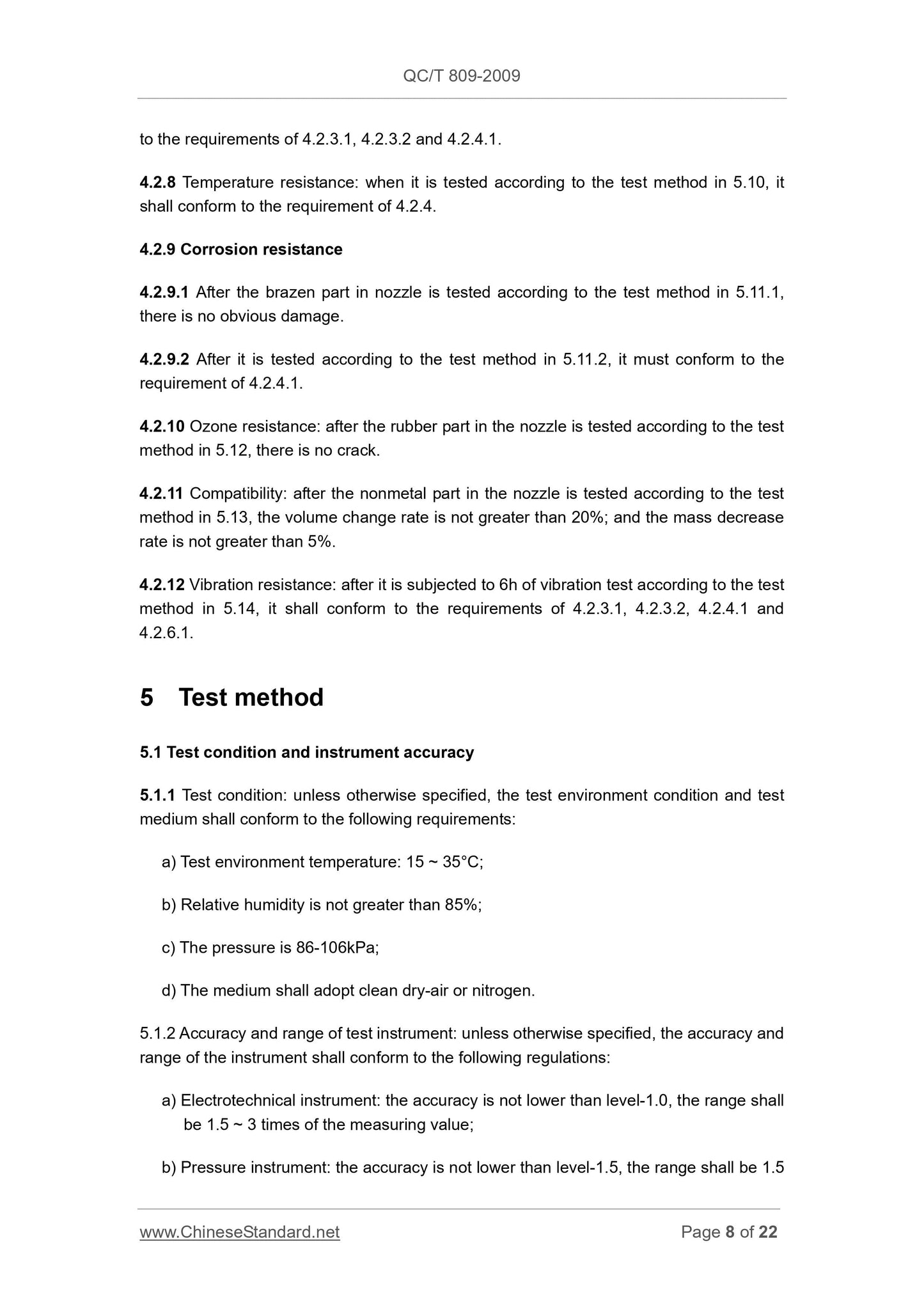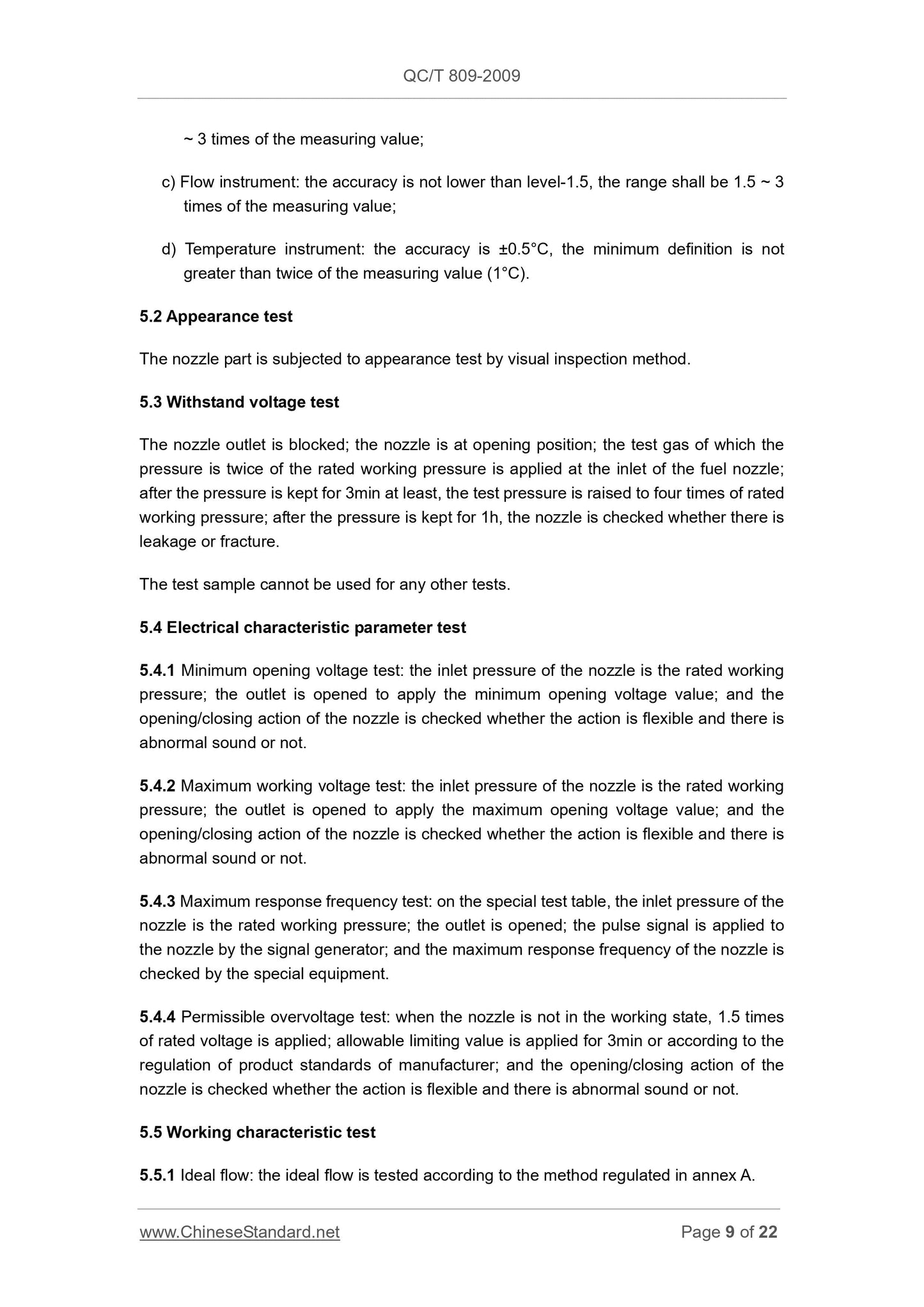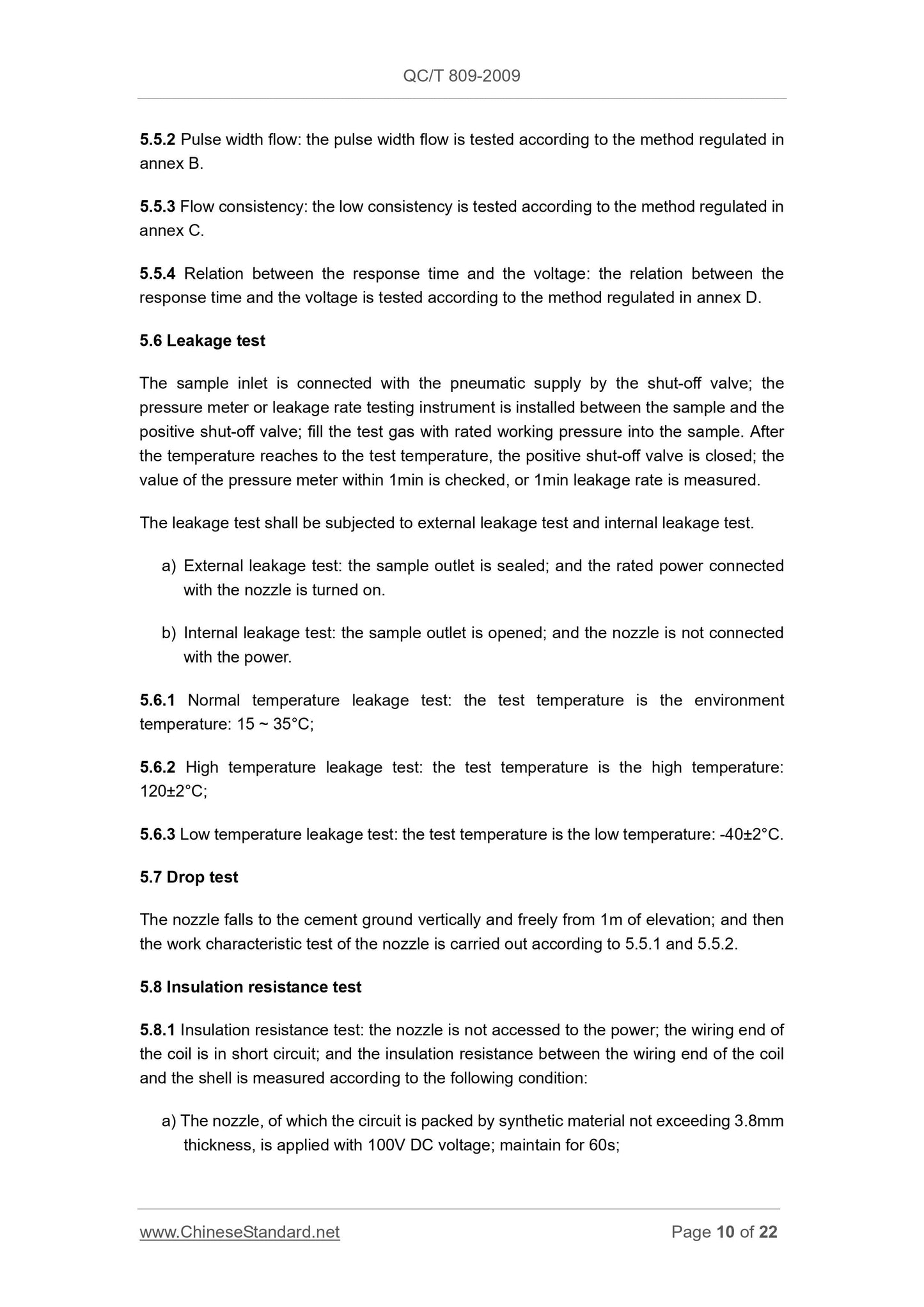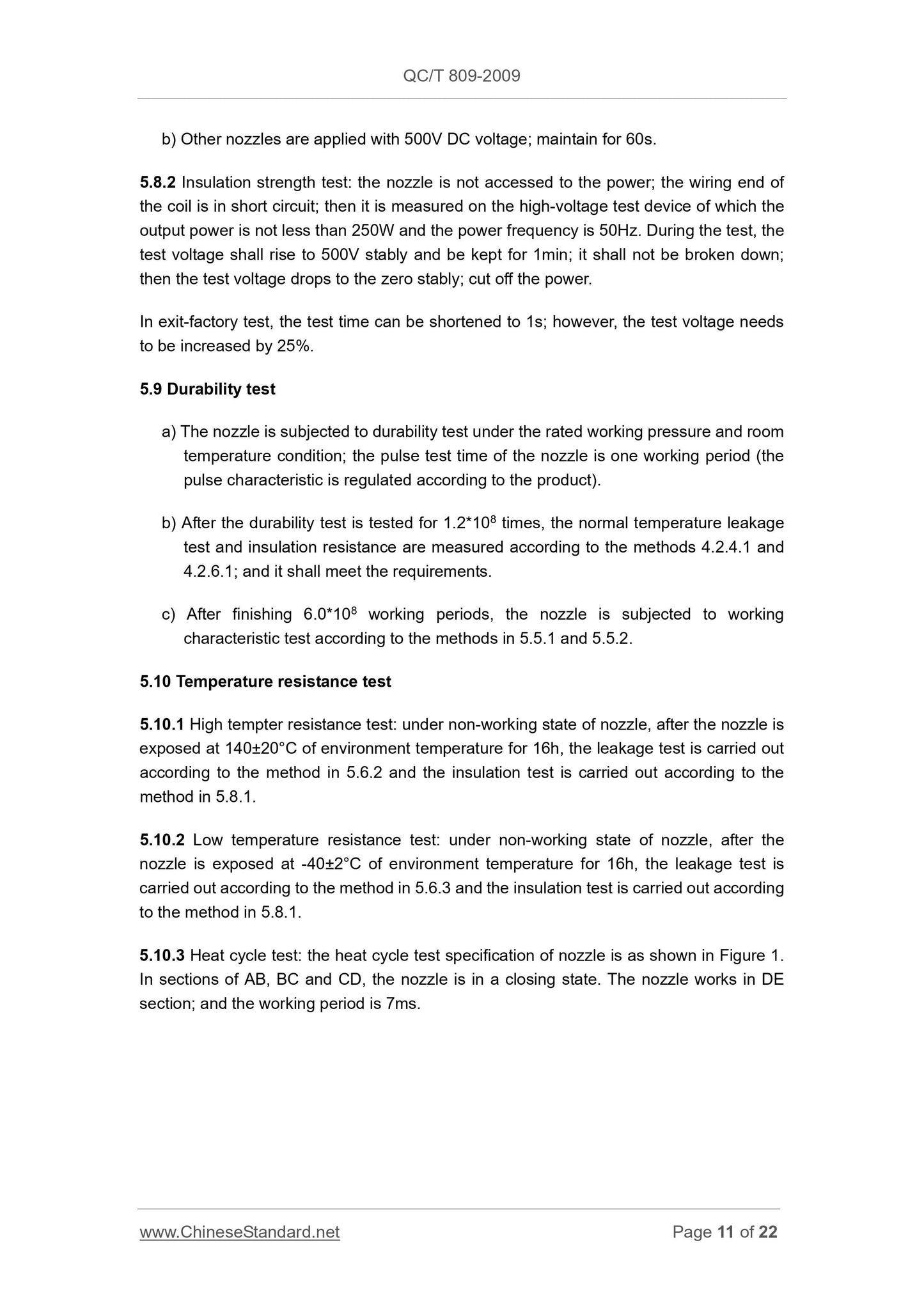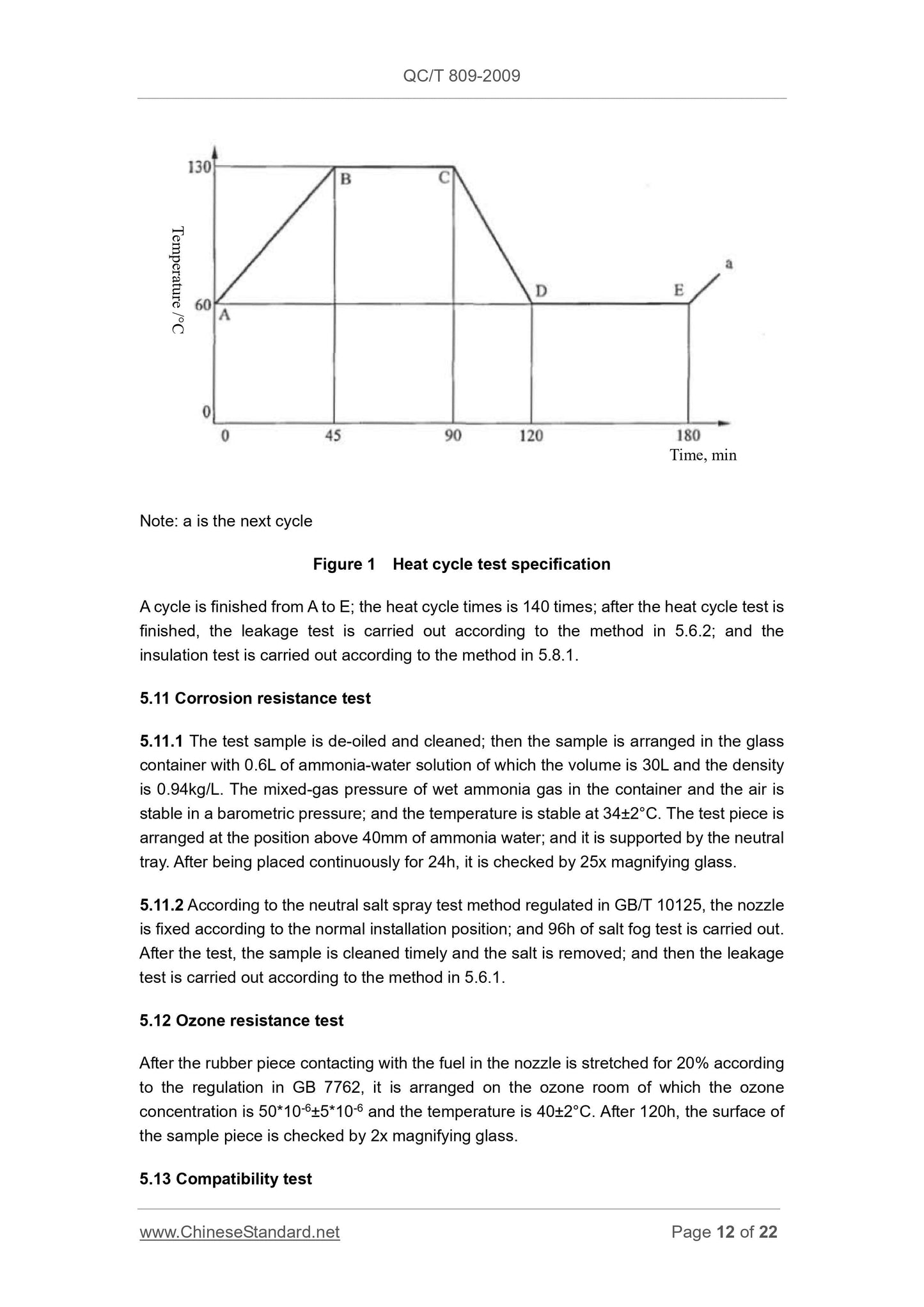1
/
of
12
PayPal, credit cards. Download editable-PDF & invoice in 1 second!
QC/T 809-2009 English PDF (QC/T809-2009)
QC/T 809-2009 English PDF (QC/T809-2009)
Regular price
$150.00 USD
Regular price
Sale price
$150.00 USD
Unit price
/
per
Shipping calculated at checkout.
Couldn't load pickup availability
Delivery: 3 seconds. Download true-PDF + Invoice.
Get QUOTATION in 1-minute: Click QC/T 809-2009
Historical versions: QC/T 809-2009
Preview True-PDF (Reload/Scroll if blank)
QC/T 809-2009: Nozzle of gas-fired vehicle
QC/T 809-2009
QC
AUTOMOBILE INDUSTRY STANDARD
OF THE PEOPLE’S REPUBLIC OF CHINA
ICS 43.040.60
T47
Nozzle of gas-fired vehicle
ISSUED ON. NOVEMBER 17, 2009
IMPLEMENTED ON. APRIL 1, 2010
Issued by. Ministry of Industry and Information Technology
Table of Contents
Forward ... 3
1 Scope ... 4
2 Normative references ... 4
3 Terms and definitions ... 5
4 Requirements ... 6
5 Test method ... 8
6 Inspection rules ... 13
7 Mark, package, transportation and storage ... 14
8 Exit-factory documents ... 15
Annex A ... 17
Annex B ... 18
Annex C ... 20
Annex D ... 21
Forward
This Standard was proposed by National Technical Committee of Auto Standardization.
This standard shall be under the jurisdiction of National Technical Committee of Auto
Standardization.
Drafting organizations of this Standard. China Automotive Engineering Research Institute
Co., Ltd., the First Jiefang Automobile Manufacturing Corp, United Automotive Electronic
Systems Co. Ltd., Chongqing Guoneng Investment Co., Ltd.
Main drafters of this Standard. Li Kaiguo, Chen Wanying, Wang Yiguang, Jia Yu, Li Jingbo,
Xie Jiming and Wang Kai.
This Standard is issued for the first time.
Nozzle of gas-fired vehicle
1 Scope
This Standard specifies the technical requirements, test methods, inspection rules, mark,
package, transportation, storage etc. of nozzle of gas-fired vehicle (hereinafter referred to
as nozzle).
This Standard is applicable to the gas-fired nozzle that, under the condition of
environment temperature of -40 ~ 120°C, complies with the vehicle compressed natural
gas of GB 18047 or that uses the vehicle liquefied petroleum gas in GB 19159 as the
working medium.
2 Normative references
The provisions in following documents become the provisions of this Standard through
reference in this Standard. For dated references, the subsequent amendments (excluding
corrigendum) or revisions do not apply to this Standard, however, parties who reach an
agreement based on this Standard are encouraged to study if the latest versions of these
documents are applicable. For undated references, the latest edition of the referenced
document applies.
GB/T 191 Packaging - Pictorial Marking for Handling of Goods
GB/T 4942.2 Degrees of Protection Provided by Enclosures for Low-voltage Apparatus
GB/T 7762 Rubber, Vulcanized or Thermoplastic - Resistance to Ozone
Cracking-Static Strain Test
GB 9969.1 General Principles for Preparation of Instructions for Use of Industrial
Products
GB/T 10125 Corrosion Tests in Artificial Atmospheres - Salt Spray Tests
GB/T 17895 Natural Gas Vehicle and Liquefied Petroleum Gas Vehicle – Vocabulary
GB 18047 Vehicle Compressed Natural Gas
GB 19159 Automotive Liquefied Petroleum Gas
3.11 Fuel flow error variability
In a pulse width, the ratio OF difference BETWEEN a nozzle’s flow AND the flow average
value of the nozzle group within this pulse width TO the average value.
4 Requirements
4.1 General requirements
4.1.1 The nozzle shall be manufactured according to the product drawings and technical
documents that are approved by the specified procedure.
4.1.2 The rated voltage of the nozzle is DC 12V or DC 24V.
4.1.3 Minimum opening voltage. the minimum opening voltage, for DC 12V rated voltage,
is DC 6V; and the minimum opening voltage, for DC 24V rated voltage, is DC 12V.
4.1.4 Maximum working voltage. the maximum working voltage, for DC 12V rated voltage,
is DC 18V; and the maximum working voltage, for DC 24V rated voltage, is DC 36V.
4.1.5 When in power failure, the nozzle is in closing state.
4.1.6 The splash-proof performance of the nozzle shall conform to the regulations of GB/T
4942.2.
4.1.7 The material used for manufacturing nozzle shall be compatible with the fuel used.
4.1.8 The outer surface of the nozzle shall be smooth, without any scratching, etc.
4.2 Performance requirements
4.2.1 Pressure resistance. when the pressure resistance test is carried out according to
the test method in 5.3, the leakage or crack is allowed; however, the fracture is not
allowed before the leakage.
4.2.2 Electrical characteristics parameters
4.2.2.1 Minimum opening voltage. when it is tested according to the test method in 5.4.1, it
shall work normally, without abnormal sound.
4.2.2.2 Maximum working voltage. when it is tested according to the test method in 5.4.2,
it shall work normally, without abnormal sound.
4.2.2.3 Maximum response frequency. when it is tested according to the test method in
5.4.3, it must conform to the regulation of product standards of manufacturer.
to the requirements of 4.2.3.1, 4.2.3.2 and 4.2.4.1.
4.2.8 Temperature resistance. when it is tested according to the test method in 5.10, it
shall conform to the requirement of 4.2.4.
4.2.9 Corrosion resistance
4.2.9.1 After the brazen part in nozzle is tested according to the test method in 5.11.1,
there is no obvious damage.
4.2.9.2 After it is tested according to the test method in 5.11.2, it must conform to the
requirement of 4.2.4.1.
4.2.10 Ozone resistance. after the rubber part in the nozzle is tested according to the test
method in 5.12, there is no crack.
4.2.11 Compatibility. after the nonmetal part in the nozzle is tested according to the test
method in 5.13, the volume change rate is not greater than 20%; and the mass decrease
rate is not greater than 5%.
4.2.12 Vibration resistance. after it is subjected to 6h of vibration test according to the test
method in 5.14, it shall conform to the requirements of 4.2.3.1, 4.2.3.2, 4.2.4.1 and
4.2.6.1.
5 Test method
5.1 Test condition and instrument accuracy
5.1.1 Test condition. unless otherwise specified, the test environment condition and test
medium shall conform to the following requirements.
a) Test environment temperature. 15 ~ 35°C;
b) Relative humidity is not greater than 85%;
c) The pressure is 86-106kPa;
d) The medium shall adopt clean dry-air or nitrogen.
5.1.2 Accuracy and range of test instrument. unless otherwise specified, the accuracy and
range of the instrument shall conform to the following regulations.
a) Electrotechnical instrument. the accuracy is not lower than level-1.0, the range shall
be 1.5 ~ 3 times of the measuring value;
b) Pressure instrument. the accuracy is not lower than level-1.5, the range shall be 1.5
5.5.2 Pulse width flow. the pulse width flow is tested according to the method regulated in
annex B.
5.5.3 Flow consistency. the low consistency is tested according to the method regulated in
annex C.
5.5.4 Relation between the response time and the voltage. the relation between the
response time and the voltage is tested according to the method regulated in annex D.
5.6 Leakage test
The sample inlet is connected with the pneumatic supply by the shut-off valve; the
pressure meter or leakage rate testing instrument is installed between the sample and the
positive shut-off valve; fill the test gas with rated working pressure into the sample. After
the temperature reaches to the test temperature, the positive shut-off valve is closed; the
value of the pressure meter within 1min is checked, or 1min leakage rate is measured.
The leakage test shall be subjected to external leakage test and internal leakage test.
a) External leakage test. the sample outlet is sealed; and the rated power connected
with the nozzle is turned on.
b) Internal leakage test. the sample outlet is opened; and the no...
Get QUOTATION in 1-minute: Click QC/T 809-2009
Historical versions: QC/T 809-2009
Preview True-PDF (Reload/Scroll if blank)
QC/T 809-2009: Nozzle of gas-fired vehicle
QC/T 809-2009
QC
AUTOMOBILE INDUSTRY STANDARD
OF THE PEOPLE’S REPUBLIC OF CHINA
ICS 43.040.60
T47
Nozzle of gas-fired vehicle
ISSUED ON. NOVEMBER 17, 2009
IMPLEMENTED ON. APRIL 1, 2010
Issued by. Ministry of Industry and Information Technology
Table of Contents
Forward ... 3
1 Scope ... 4
2 Normative references ... 4
3 Terms and definitions ... 5
4 Requirements ... 6
5 Test method ... 8
6 Inspection rules ... 13
7 Mark, package, transportation and storage ... 14
8 Exit-factory documents ... 15
Annex A ... 17
Annex B ... 18
Annex C ... 20
Annex D ... 21
Forward
This Standard was proposed by National Technical Committee of Auto Standardization.
This standard shall be under the jurisdiction of National Technical Committee of Auto
Standardization.
Drafting organizations of this Standard. China Automotive Engineering Research Institute
Co., Ltd., the First Jiefang Automobile Manufacturing Corp, United Automotive Electronic
Systems Co. Ltd., Chongqing Guoneng Investment Co., Ltd.
Main drafters of this Standard. Li Kaiguo, Chen Wanying, Wang Yiguang, Jia Yu, Li Jingbo,
Xie Jiming and Wang Kai.
This Standard is issued for the first time.
Nozzle of gas-fired vehicle
1 Scope
This Standard specifies the technical requirements, test methods, inspection rules, mark,
package, transportation, storage etc. of nozzle of gas-fired vehicle (hereinafter referred to
as nozzle).
This Standard is applicable to the gas-fired nozzle that, under the condition of
environment temperature of -40 ~ 120°C, complies with the vehicle compressed natural
gas of GB 18047 or that uses the vehicle liquefied petroleum gas in GB 19159 as the
working medium.
2 Normative references
The provisions in following documents become the provisions of this Standard through
reference in this Standard. For dated references, the subsequent amendments (excluding
corrigendum) or revisions do not apply to this Standard, however, parties who reach an
agreement based on this Standard are encouraged to study if the latest versions of these
documents are applicable. For undated references, the latest edition of the referenced
document applies.
GB/T 191 Packaging - Pictorial Marking for Handling of Goods
GB/T 4942.2 Degrees of Protection Provided by Enclosures for Low-voltage Apparatus
GB/T 7762 Rubber, Vulcanized or Thermoplastic - Resistance to Ozone
Cracking-Static Strain Test
GB 9969.1 General Principles for Preparation of Instructions for Use of Industrial
Products
GB/T 10125 Corrosion Tests in Artificial Atmospheres - Salt Spray Tests
GB/T 17895 Natural Gas Vehicle and Liquefied Petroleum Gas Vehicle – Vocabulary
GB 18047 Vehicle Compressed Natural Gas
GB 19159 Automotive Liquefied Petroleum Gas
3.11 Fuel flow error variability
In a pulse width, the ratio OF difference BETWEEN a nozzle’s flow AND the flow average
value of the nozzle group within this pulse width TO the average value.
4 Requirements
4.1 General requirements
4.1.1 The nozzle shall be manufactured according to the product drawings and technical
documents that are approved by the specified procedure.
4.1.2 The rated voltage of the nozzle is DC 12V or DC 24V.
4.1.3 Minimum opening voltage. the minimum opening voltage, for DC 12V rated voltage,
is DC 6V; and the minimum opening voltage, for DC 24V rated voltage, is DC 12V.
4.1.4 Maximum working voltage. the maximum working voltage, for DC 12V rated voltage,
is DC 18V; and the maximum working voltage, for DC 24V rated voltage, is DC 36V.
4.1.5 When in power failure, the nozzle is in closing state.
4.1.6 The splash-proof performance of the nozzle shall conform to the regulations of GB/T
4942.2.
4.1.7 The material used for manufacturing nozzle shall be compatible with the fuel used.
4.1.8 The outer surface of the nozzle shall be smooth, without any scratching, etc.
4.2 Performance requirements
4.2.1 Pressure resistance. when the pressure resistance test is carried out according to
the test method in 5.3, the leakage or crack is allowed; however, the fracture is not
allowed before the leakage.
4.2.2 Electrical characteristics parameters
4.2.2.1 Minimum opening voltage. when it is tested according to the test method in 5.4.1, it
shall work normally, without abnormal sound.
4.2.2.2 Maximum working voltage. when it is tested according to the test method in 5.4.2,
it shall work normally, without abnormal sound.
4.2.2.3 Maximum response frequency. when it is tested according to the test method in
5.4.3, it must conform to the regulation of product standards of manufacturer.
to the requirements of 4.2.3.1, 4.2.3.2 and 4.2.4.1.
4.2.8 Temperature resistance. when it is tested according to the test method in 5.10, it
shall conform to the requirement of 4.2.4.
4.2.9 Corrosion resistance
4.2.9.1 After the brazen part in nozzle is tested according to the test method in 5.11.1,
there is no obvious damage.
4.2.9.2 After it is tested according to the test method in 5.11.2, it must conform to the
requirement of 4.2.4.1.
4.2.10 Ozone resistance. after the rubber part in the nozzle is tested according to the test
method in 5.12, there is no crack.
4.2.11 Compatibility. after the nonmetal part in the nozzle is tested according to the test
method in 5.13, the volume change rate is not greater than 20%; and the mass decrease
rate is not greater than 5%.
4.2.12 Vibration resistance. after it is subjected to 6h of vibration test according to the test
method in 5.14, it shall conform to the requirements of 4.2.3.1, 4.2.3.2, 4.2.4.1 and
4.2.6.1.
5 Test method
5.1 Test condition and instrument accuracy
5.1.1 Test condition. unless otherwise specified, the test environment condition and test
medium shall conform to the following requirements.
a) Test environment temperature. 15 ~ 35°C;
b) Relative humidity is not greater than 85%;
c) The pressure is 86-106kPa;
d) The medium shall adopt clean dry-air or nitrogen.
5.1.2 Accuracy and range of test instrument. unless otherwise specified, the accuracy and
range of the instrument shall conform to the following regulations.
a) Electrotechnical instrument. the accuracy is not lower than level-1.0, the range shall
be 1.5 ~ 3 times of the measuring value;
b) Pressure instrument. the accuracy is not lower than level-1.5, the range shall be 1.5
5.5.2 Pulse width flow. the pulse width flow is tested according to the method regulated in
annex B.
5.5.3 Flow consistency. the low consistency is tested according to the method regulated in
annex C.
5.5.4 Relation between the response time and the voltage. the relation between the
response time and the voltage is tested according to the method regulated in annex D.
5.6 Leakage test
The sample inlet is connected with the pneumatic supply by the shut-off valve; the
pressure meter or leakage rate testing instrument is installed between the sample and the
positive shut-off valve; fill the test gas with rated working pressure into the sample. After
the temperature reaches to the test temperature, the positive shut-off valve is closed; the
value of the pressure meter within 1min is checked, or 1min leakage rate is measured.
The leakage test shall be subjected to external leakage test and internal leakage test.
a) External leakage test. the sample outlet is sealed; and the rated power connected
with the nozzle is turned on.
b) Internal leakage test. the sample outlet is opened; and the no...
Share
